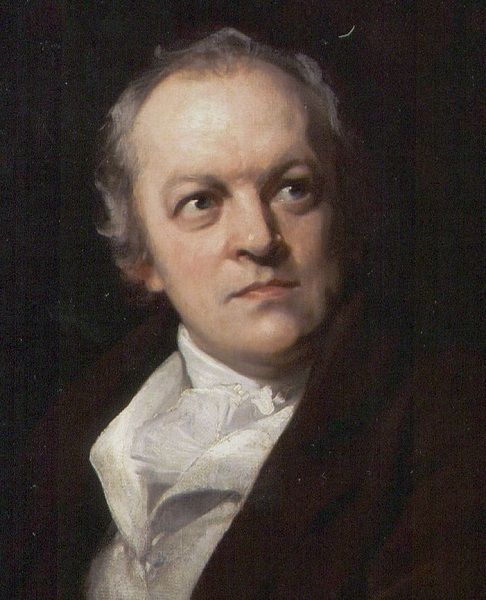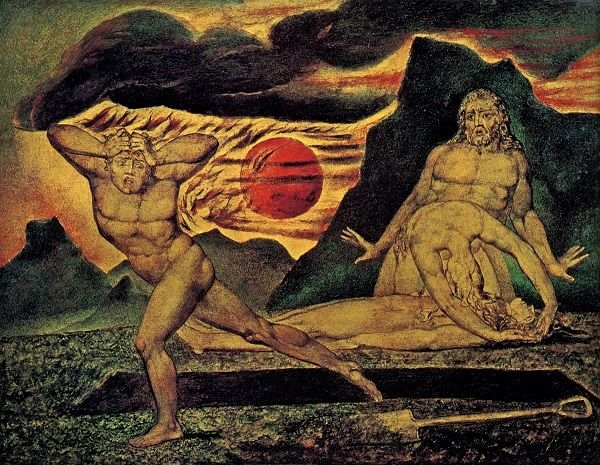The strange greatness of William Blake

Portrait of William Blake by Thomas Phillips
It seems to me that the extraordinary life and overall creativity of William Blake is not known or, more precisely, not fully understood. In English literature, no one denies that he is a genius, but the usual epithets for him are mysticism, prophecy, eccentricity, curiosity, and in the words of a nineteenth-century English writer he is a person not preceded by predecessors who can not be categorized alongside their contemporaries, nor be inherited by known or easily predictable followers.
We can start by having two creative personalities named Blake - Blake the poet, whose short portrait I present here, and Blake, one of England's great artists. William Blake, and by education, is an painter- on October 8, 1779 he enrolled to follow at the Royal Academy on Strand Street, a few hundred meters from the National Gallery of Trafalgar Square, where his watercolors, graphics, engravings, illustrations and drawings are among the most -the prices in the collection.
Briefly, Blake's exclusive artistic work is a visual reflection of what he is. His lyrics are a psychological revelation of his spiritual essence.

The body of abel found by adam and eve, by William Blake
William Blake is a Londoner, born on November 28, 1757 in the Soho neighborhood, in the James Blake family, a knitwear merchant. His mother is Catherine Wright Armitage (this is a second marriage for her, her first husband, also a knitwear trader, rests on the following year - 1751, she married James Blake for thirty). She has a total of seven children, five of whom survive. The parents of the poet are unconformist, believed to have belonged to the so- "Moravian Church", whose emblem is the Lamb of God - an easily recognizable image in Blake's work.
He gets his education at home, from his mother, learns himself to paint by reproducing pictures of Greek antiquities brought by his father. His important book is the Bible, after a while, though briefly, a member of the Church of New Orleans of the Church of New York. Already in his childhood (from the age of four) there are visions of angels, ghostly monks, God, conversations with archangel Gabriel and Virgin Mary, as well as with historical personalities. At the age of ten, he attends a painting school, 14 becomes an apprentice at the engraver James Bayser and works twelve hours a day, six days a week. After his father's death with his friend, he opened a printing house.
After leaving the Royal Academy, in 1783 he married for five years younger Catherine Bauer, the daughter of a vegetable grower. He has recently experienced a love disappointment. They don't have children, but the other brothers and sisters of Blake also remain childless. He didn't manage to meet Emmanuel Swedenborg (who dies in London in 1772), but communicated with a number of well-known contemporaries - the memorialist Thomas Paine, one of the founding fathers of the United States, William William Godwin (the father-in-law of Shelley's poet and father of Mary Shelley), disappointed with Swedenborg and became a fan of the well-known alchemic Paracelsus.
In addition to painting, he wrote his first poem at the age of 12, published his first book Poetic Eskise in 1783, followed by the famous "Songs of Innocence" (1789) and Songs of Experience (1794). Each copy of "Songs of Innocence" is made uniquely, and the poetry arrangement is different in the individual specimens. His scholarships are unsuccessful, and Blake continues to live in isolation. However, he illustrates the books of his contemporaries, such as the founder of feminism in England, Milton's "Lost Paradise" and the unfinished John Bunyan's "Path of Pilgrim" and Dante's "Divine comedy".

The great red dragon, by William Blake
Among his scandalous ideas are the expression of sympathy for the Great French Revolution (writes the poem in seven books "The French Revolution" in 1791), the approval of "free love". The doctrine of "free love," developed in the nineteenth century, is associated with Mary Wollstonecraf (emancipation of the monogamy) and William Godwin, but these are, above all, views of marriage such as slavery, a protest against state restrictions on sexual activities (such as homosexuality, adultery). His most revolutionary book is "The Marriage of Heaven and Hell" (1790-1793), an original and difficult prose.
HEAVEN AND HELL
Prisons are built with stones of Law, Brothels with bricks of
Religion.
The pride of the peacock is the glory of God.
The lust of the goat is the bounty of God.
The wrath of the lion is the wisdom of God.
The nakedness of woman is the work of God.
Excess of sorrow laughs. Excess of joy weeps.
The roaring of lions, the howling of wolves, the raging of the
stormy sea, and the destructive sword. are portions of
eternity too great for the eye of man.
The fox condemns the trap, not himself.
Joys impregnate. Sorrows bring forth.
His wife complains, "I rarely share the company with Mr. Blake, he's always in Heaven," and one contemporary calls him "harmless crazy" (among other things, psychiatrists have tried to analyze his behavior nowadays). Realizing Catherine's childlessness, he proposes to accept a second wife in their family.
He starts work on the so-called (1795), "The Book of Ahania"(1795), "The Book of Los"(1795), "The Four Zoas" (1795-1804), "America a Prophecy" (1793), "Europe a Prophecy", "The Specter of Abel" the years of book publishing are approximate due to the specific technique of their publishing (he engraves on copper engraving plates using different techniques) and in fact his editions of life are of two types: "decorated with illustrations" and "undeclared".
Blake makes an exhibition in his brother's grocery store. In 1803, he was ridiculously charged with state treason for supposed offensive words to the king, but the court justifies him. In his work appear erotic themes - a central motif has erect a penis. In the old days, he enjoyed admirers - young artists from the Circle of the Ancient of Sorum, or the "Praising" who call it the "divine Blake." He died on August 12, 1827, buried five days later in a common grave, as he did with non-conformists, and his parents lived in the same cemetery. At least four carcasses were laid in this tomb, but after repairing the area after 1965, the tombstones were exported and the precise location of his grave is unknown.
According to some, he painted a portrait of Catherine, who is considered lost, before his death. His latest works are unfinished satire in the prose "Island of the Moon" and his most ambitious work - "Jerusalem". In fact, Blake has two works with such a title: his longest "prophetic book", Jerusalem The Emanation of the Giant Albion (1804-1820) and the Jerusalem anthem (1804-1808), a preface to another prophetic book "Milton "

Nebuchadnezzar by William Blake
After the death of his wife, the manuscripts were inherited by one of his young friends from the Ancient Band, Frederick Teedum, who burned some of them as too heresy and radical. Another friend of his, the artist John Linell, erased the sexual images in his paintings.
The famous English poet, romantic William Wordsworth, commented: "There is no doubt that this man was crazy, but there is something in his madness that I have a stronger interest than the Lord Byron's and Walter Scott's goodwill." The attitude towards him is changing from the generation of pre-raphelites, by WB Yeats, often interpreted as a romantic and pre-romantic, and T. Elliot very sophistically determines it as follows: "... Dante is a classic, and Blake a poet of genius ".
great job @godflesh

Thanks
Extraordinary post. Always liked William Blake's work!